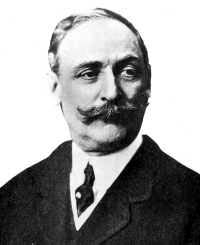The Chihuahua al Pacifico Copper Canyon rail journey
through the Sierra Tarahumara is one of the world's most dramatic train
rides. Spectacular in scenery and engineering, the line spans 37 bridges,
passes through 86 tunnels and rises 8,000 feet in the 410 mile trip from
Los Mochis to Chihuahua City.
This amazing rail line owes its creation to the farsightedness and creativity
of two nineteenth century American visionaries—Albert Kinsey Owen
and Arthur Edward Stilwell (as seen in photo).
A Pennsylvania-born civil engineer, Owen saw the enormous potential of
the huge natural harbor at Topolobampo and conceived the idea of a Pacific
to Atlantic rail route through Mexico's rugged Sierra Madre as a land
bridge connecting markets in the Far East with Europe. He had worked
as a surveyor on the Laredo-Mexico City Railroad and knew that another
line could be built through the seemingly impenetrable Sierra. At this
time the French had failed in their attempt to build a waterway across
Panama so a binational railroad seemed a more viable alternative.
But Owen was a dreamer and turned his efforts to founding a utopian American
colony at Topolobampo. The colony failed after only five years.
Another man, who had practical business skills as well as vision, carried
on the quest for the railroad. He was Arthur Edward Stilwell, scion of
a wealthy Rochester, New York family, who, at age 32, became the nation's
youngest railroad owner.
Stilwell planned his rail line to run from Kansas City to Presidio, Texas,
then join a Mexican line across the Rio Grande at Ojinaga, which would
run through the state of Chihuahua and cross the Sierras to reach Topolobampo—several
hundred miles shorter than the Union Pacific's Kansas City to San Francisco
line.
Financing was obtained in the U.S. from local communities and oil companies,
and in Mexico by the government of Porfirio Diaz promising land and cash
concessions to wealthy entrepreneurs including Enrique Creel and Luis
Terrazas.
Construction began and the tracks pushed forward throughout the 1890's.
The Topolobampo-El Fuerte segment was completed in1903, followed by the
Chihuahua-Creel section in 1907.
Then the Mexican Revolution began in 1910 and over the next ten years
put a stop to the project—the Mexican government could not meet
its economic commitments, and Pancho Villa attacked the trains. Villa
was miffed at being snubbed by Luis Terrazas at a ceremony celebrating
the completion of a portion of the route. Terrazas correctly believed
that Villa had been rustling his cattle. Because of all this, the Stilwell
interests were forced into receivership.
Plans to complete the railroad languished for the next twenty years.
Then, in 1940, President Lazaro Cardenas nationalized Mexico's railroads
and announced that the government would complete the several hundred
kilometers that still remained to be built. In 1941 the remaining route
was surveyed and, on November 22, 1961, the first train arrived in Los
Mochis from Chihuahua—almost a century after Owen first had his
vision.
The railroad was completed by the Mexican government at a cost of over
a billion pesos, without foreign aid. A colossal project far beyond the
capacities of most developing nations. Engineering marvels abound: the
El Descanso Tunnel extends over 6,000 feet; the Chinipas Bridge is 355
feet high; the Rio Fuerte Bridge is over 1,600 feet long. The gentle
curvature of the rails, the gradual grades never exceeding 2.5%, and
widespread use of 6-mile long spans of rail make for a smooth and comfortable
passage.
Click Here for information on our Copper Canyon Tours.



